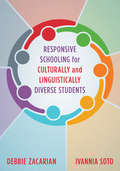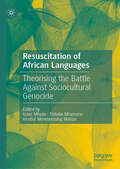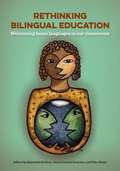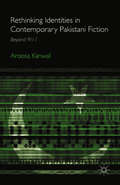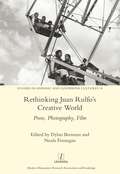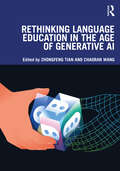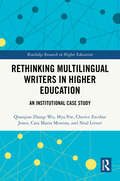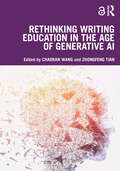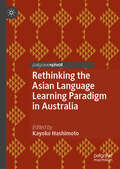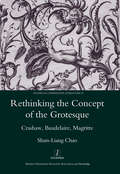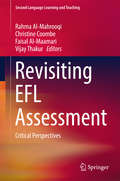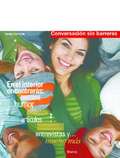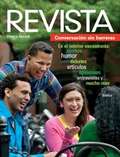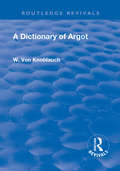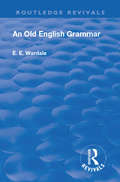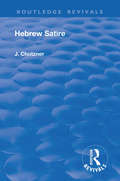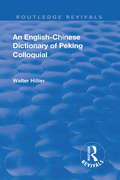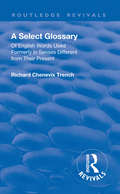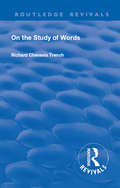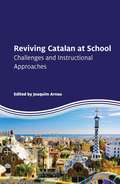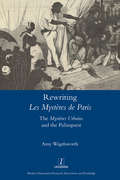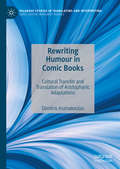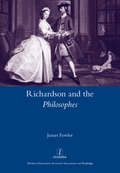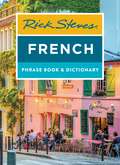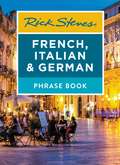- Table View
- List View
Responsive Schooling for Culturally and Linguistically Diverse Students
by Debbie Zacarian Ivannia SotoA strengths-based approach to making sure what we teach is central to who we teach. Rapidly changing and diverse student populations necessitate culturally responsive schooling. It can be a challenging balancing act for educators to respect diversity and teach to each student’s needs while adhering to restrictive curricula that mandate the use of standard English. Responsive Schooling for Culturally and Linguistically Diverse Students offers a balanced approach to developing students’ academic language proficiency while simultaneously honoring, acknowledging, and valuing the richness of their home and community languages and cultures. Debbie Zacarian and Ivannia Soto provide a practical framework within which schools and educators can make students’ personal, cultural, and social identities central to the curriculum by drawing on the experiences and interests they bring to the classroom. Filled with examples of responsive teaching and opportunities to reflect on current practice, the book is a rich resource for teachers and school leaders alike.
Resuscitation of African Languages: Theorising the Battle Against Sociocultural Genocide
by Isaac Mhute Zilibele Mtumane Vimbai Moreblessing MatizaThis book argues the case for indigenous African languages, which have been stripped of their importance and are now often overshadowed - both officially, through governmental language policies, and informally, through attitudes and ideologies - by former colonial languages. The authors present case studies from a range of countries in the region, arguing that languages tell us peoples’ identities, and that by dropping their own languages in favour of foreign and imperialist languages they lose their culture, history and identity as well. The book addresses many of the challenges currently associated with African languages, with the intention of influencing policy and practice in favour of their resuscitation. This book will be of interest to policy makers, academics and tertiary students in fields including Language Policy and Planning, Language Revitalisation, Heritage Language Learning, Indigenous and Endangered Languages, and Language Attitudes and Ideologies.
Rethinking Bilingual Education: Welcoming Home Languages In Our Classrooms
by Elizabeth Barbian"The articles in Rethinking Bilingual Education show the many ways that teachers bring students’ home languages into their classroom—from powerful examples of social justice curriculum taught by bilingual teachers to ideas and strategies for how to honor students’ languages in schools with no bilingual program. We see bilingual educators work to keep equity at the center and to build solidarity among diverse communities. Teachers and students speak to the tragedy of language loss but also about the inspiring work to revitalize languages on the brink of disappearance and to defend and expand bilingual education programs"--Publisher's website.
Rethinking Identities in Contemporary Pakistani Fiction: Beyond 9/11
by A. KanwalThis book focuses on the way that notions of home and identity have changed for Muslims as a result of international 'war on terror' rhetoric. It uniquely links the post-9/11 stereotyping of Muslims and Islam in the West to the roots of current jihadism and the resurgence of ethnocentrism within the subcontinent and beyond.
Rethinking Juan Rulfo's Creative World: Prose, Photography, Film (Legenda)
by Nuala Finnegan Dylan BrennanThough primarily known for his haunting, enigmatic novel Pedro Páramo and the unrelenting depictions of the failures of post-revolutionary Mexico in his short story collection, El Llano en llamas, Juan Rulfo also worked as scriptwriter on various collaborative film projects and his powerful interventions in the area of documentary photography ensure that he continues to inspire interest worldwide. Bringing together some of the most significant names in Rulfian scholarship, this anthology engages with the complexity and diversity of Rulfo’s cultural production. The essays in the collection bring the Rulfian texts into dialogues with other cultural traditions and techniques including the Japanese Noh or "mask" plays and modernist experimentation in the Irish language. They also deploy diverse theoretical frameworks that range from Roland Barthes’ work on studium and punctum in photography to Henri Lefebvre’s ideas on space and spatiality and the postmodern insights of Jean Baudrillard on the nature of the simulacrum and the hyperreal. In this way, innovative approaches are brought to bear on the Rulfian texts as a way of illuminating the rich tensions and anxieties they evoke about Mexico, about history, about art and about the human condition.
Rethinking Language Education in the Age of Generative AI
by Zhongfeng Tian Chaoran WangRethinking Language Education in the Age of Generative AI bridges the gap between theory, research, and practice in AI and language education. Through conceptual pieces, empirical studies, and practical applications, this book provides critical insights and implications for reimagining language education in the age of generative AI.The contributors explore a wide range of issues, reflections, and innovations in AI and language education across diverse contexts, including English as a Second Language (ESL), English as a Foreign Language (EFL), foreign language learning, postsecondary pathways programs for international students, and language teacher education programs. Topics examined include critical AI literacy, GenAI-informed second language teaching and assessment, teacher and student perceptions, tool development for language learning, as well as ethical considerations, policies, and guidelines. The book incorporates interdisciplinary perspectives, such as L2/foreign language studies, education, and applied linguistics, as well as global insights from countries like the United States, Canada, South Korea, Thailand, Indonesia, and the Philippines.This book is essential for students and researchers seeking to leverage AI to enhance language teaching and learning in innovative, critical, ethical, and responsible ways.
Rethinking Multilingual Writers in Higher Education: An Institutional Case Study (Routledge Research in Higher Education)
by Neal Lerner Qianqian Zhang-Wu Mya Poe Cherice Escobar Jones Cara Marta MessinaRethinking Multilingual Writers in Higher Education: An Institutional Case Study explores the complexities of multilingual students as language users and learners, emphasizing the distinctive assets that they bring to their education and the ways in which institutions of higher education can better meet their needs.Teachers, university administrators, advisors, and other support staff will gain an understanding of the resources, challenges, and successes of this growing student population and become better equipped to provide them with the best possible educational opportunities. Through mixed-methods case studies focusing on the Northeastern University Writing Program and Writing Center, the authors unpack the complexity of multilingual students’ identities and languaging to challenge deficit and homogenizing narratives that overlook their linguistic assets and diverse educational experiences. Working within and against university categories for collecting information about students and assessing their writing, authors point out the limits of terms such as “international” and the problems with dichotomous L1/L2 and native/nonnative speaker labels. Finally, the book offers lessons learned about the importance of conducting program self-study to inform research and pedagogy for higher education institutions around the world.This book will appeal to writing studies and linguistics scholars with interests in multilingualism, assessment, and mobility, as well as institutional stakeholders and researchers of higher education and multicultural education.
Rethinking Writing Education in the Age of Generative AI
by Zhongfeng Tian Chaoran WangBringing together leading scholars and practitioners, Rethinking Writing Education in the Age of Generative AI offers a timely exploration of pressing issues in writing pedagogies within an increasingly AI-mediated educational landscape.From conceptual and empirical work to theory-guided praxis, the book situates the challenges we face today within the historical evolution of writing education and our evolving relationship with AI technologies. Covering a range of contexts such as L2/multilingual writing, first-year writing, writing centers, and writing program administration and faculty development, the book examines various AI-informed writing pedagogies and practices. Drawing on interdisciplinary perspectives from writing studies, education, and applied linguistics, the book bridges theory and practice to address critical questions of innovation, ethics, and equity in AI-supported teaching.This book is essential for writing educators and researchers looking to leverage AIs to facilitate the teaching and learning of writing in critical and transformative ways.
Rethinking the Asian Language Learning Paradigm in Australia
by Kayoko HashimotoThis edited book calls for a rethink of the current Asian language learning paradigm that frames Asian languages as strategic and economic tools, rather than an inherent part of Australian society. As an increasing number of Australians have Asian ancestry and speak languages other than English at home, it argues that we must reset the paradigm and understand Asian languages as intrinsically Australian to maximise existing linguistic and cultural assets. The interdisciplinary chapters, focusing on Japanese, Chinese, Korean and Vietnamese, report on the state of Asian language learning and teaching in mainstream educational settings as well as heritage language education in informal contexts in Australia. With an additional chapter on implications for other Anglophone countries, this volume urges a transformative approach to Asian language education in the context of current global migration and multilingual demographics in order to nurture global citizenship and honour linguistic diversity. The book will be suitable for academics, policy makers, practitioners and teachers.
Rethinking the Concept of the Grotesque: Crashaw, Baudelaire, Magritte
by Shun-Liang ChaoHow are we to define what is grotesque, in art or literature? Since the Renaissance the term has been used for anything from the fantastic to the monstrous, and been associated with many artistic genres, from the Gothic to the danse macabre. Shun-Liang Chao's new study adopts a rigorous approach by establishing contradictory physicality and the notion of metaphor as two keys to the construction of a clear identity of the grotesque. With this approach, Chao explores the imagery of Richard Crashaw, Charles Baudelaire, and Rene Magritte as individual exemplars of the grotesque in the Baroque, Romantic, and Surrealist ages, in order to suggest a lineage of this curious aesthetic and to cast light on the functions of the visual and of the verbal in evoking it.
Revisiting EFL Assessment
by Rahma Al-Mahrooqi Christine Coombe Faisal Al-Maamari Vijay ThakurThis book examines acknowledged practices and demonstrates to teachers how to make the most out of their assessment practices. It also explores different assessment methods for skills such as reading, writing, listening and speaking. Forecasting the future of assessment and where concepts like alternative assessment and dynamic assessment are heading, it also shows how relatively new teaching methods such as communicative methodologies and problem-based learning are reflected in assessment. This book represents a forum where contributors have presented their research and innovative ideas and practices on the important topic of assessment and opened a fresh debate on it. It offers an excellent reference guide for EFL teachers, practitioners, researchers and testing and assessment specialists. Each chapter examines central issues inassessment and their connection with teaching and learning in EFL contexts.
Revista: Conversación sin barreras
by José A. BlancoGet students talking with Revista! This conversational, 6-lesson program includes readings and films specifically chosen to generate controversy and capture students' interest.
Revival: (French-English) (Routledge Revivals)
by W Knoblauch vonStudents and Readers of French Literature, who require a more complete dictionary of Argot than the present volume, should consult these learned and excellent works.
Revival: An Old English Grammar (1922) (Routledge Revivals)
by Edith Elizabeth WardaleOld English is the name given to the language spoken by the Germanic inhabitants of Britain till about the time of the Conquest, or, according to some scholars, till about 1100. It is a member of the western division of Germanic, which is itself a branch of the large Indo-Germanic family of languages. This book gives an overview of Old English and its grammar.
Revival: Hebrew Satire (1911) (Routledge Revivals)
by Joseph ChotznerVery little attention has hitherto been paid by authors generally to those works forming part of Hebrew literature, in which much of delightful satire is predominant. The object of this volume, therefore, is to make the reader familiar with the contents of several of these writings which may prove interesting to him.
Revival: New Edition Enlarged by Sir Trelawny Backhouse and Sidney Barton (Routledge Revivals)
by Walter Caine HillierMany of the marks attached to the phonetic rendering of the Chinese words in this volume differ from those assigned to them in the dictionaries. These apparent discrepencies are intentional, the tones being given as they are applied, or appear to the ear of the compiler to be applied, by the natives of Peking.
Revival: Of English Words Used Formerly in Senses Different from their Present (Routledge Revivals)
by Richard Chenevix TrenchThis volume is intended to be a contribution to a special branch of the study of our own language. It proposes to trace in a popular manner and for general readers the changes of meaning which so many of its words have undergone; words which, as current with us as they were with out forefathers, yet meant something different on their lips from what they mean on ours.
Revival: On the Study of Words (Routledge Revivals)
by Richard Chenevix TrenchFirst published in 1904, this book contains the conclusions of a series of lectures exploring the moral and historical value of single words. The author argues that, just as wisdom and knowledge are discoverable in books, so too are these treasures to be found in individual words themselves.
Reviving Catalan at School
by Joaquim ArnauThis book presents a comprehensive picture of languages and schools in Catalan-speaking countries, making much of the information available in English for the first time. The chapters examine multiple aspects of the language situation in these countries, including: the recovery of Catalan in schools; the position and status of the majority languages (English and Spanish); language-in-education policies in a multilingual, multicultural context; the possibility of multilingual competence; and the successes and failures of instructional processes.
Rewriting 'Les Mystères de Paris': The 'Mystères Urbains' and the Palimpsest (Legenda)
by Amy WigelsworthKey works of popular fiction are often rewritten to capitalize on their success. But what are the implications of this rewriting process? Such is the question addressed by this detailed study of several rewritings of Eugène Sue’s Mystères de Paris (1842-43), produced in the latter half of the nineteenth century, in response to the phenomenal success of Sue’s archetypal urban mystery. Pursuing a compelling analogy between city and text, and exploring the resonance of the palimpsest trope to both, Amy Wigelsworth argues that the mystères urbains are exemplary rewritings, which shed new light on contemporary reading and writing practices, and emerge as early avatars of a genre still widely consumed and enjoyed in the 21st century.
Rewriting Humour in Comic Books: Cultural Transfer and Translation of Aristophanic Adaptations (Palgrave Studies in Translating and Interpreting)
by Dimitris AsimakoulasThis book examines comic book adaptations of Aristophanes’ plays in order to shed light on how and why humour travels across cultures and time. Forging links between modern languages, translation and the study of comics, it analyses the Greek originals and their English translations and offers a unique, language-led research agenda for cultural flows, and the systematic analysis of textual norms in a multimodal environment. It will appeal to students and scholars of Modern Languages, Translation Studies, Comics Studies, Cultural Studies and Comparative Literature.
Richardson and the Philosophes
by James FowlerIn mid-eighteenth-century Europe, a taste for sentiment accompanied the 'rise of the novel', and the success of Samuel Richardson (1689-1761) played a vital role in this. James Fowler's new study is the first to compare the response of the most famous philosophes to the Richardson phenomenon. Voltaire, who claims to despise the novel, writes four 'Richardsonian' fictions; Diderot's fascination with the English author is expressed in La Religieuse, Rousseau's in Julie - the century's bestseller. Yet the philosophes' response remains ambivalent. On the one hand they admire Richardson's ability to make the reader weep. On the other, they champion a range of Enlightenment beliefs which he, an enthusiast of Milton, vehemently opposed. In death as in life, the English author exacerbates the philosophes' rivalry. The eulogy which Diderot writes in 1761 implicitly asks: who can write a new Clarissa? But also: whose social, philosophical or political ideas will triumph as a result?
Rick Steves French Phrase Book & Dictionary (Rick Steves Travel Guide)
by Rick StevesBonjour! From ordering steak frites in Paris to making new friends in Nice, it helps to speak some of the native tongue in France. Rick Steves offers well-tested French words and phrases that come in handy in a variety of situations. Inside you'll find:Helpful phrases for everyday circumstances, complete with phonetic spellingAn English-French and French-English dictionaryTips for small talk and local lingo with Rick's signature sense of humor A tear-out cheat sheet for continued language practice as you sip wine at a brasserie (no internet connection required!)Informative, concise, and practical, Rick Steves French Phrase Book & Dictionary is an essential item for any traveler's sac à dos.
Rick Steves French, Italian & German Phrase Book (Rick Steves Travel Guide)
by Rick StevesWhen ordering a café au lait in Paris, calamari in Venice, or bratwurst in Munich, it helps to speak some of the native tongue. Rick Steves offers well-tested words and phrases that come in handy in a variety of situations. Inside you'll find:Key phrases for use in everyday circumstances, complete with phonetic spellingAn English-French/Italian/German dictionaryTips for small talk and local lingo with Rick's signature sense of humor A tear-out cheat sheet for continued language practice (no internet connection required!)Informative, concise, and practical, Rick Steves French, Italian & German Phrase Book is an essential item for any traveler's pocket.
